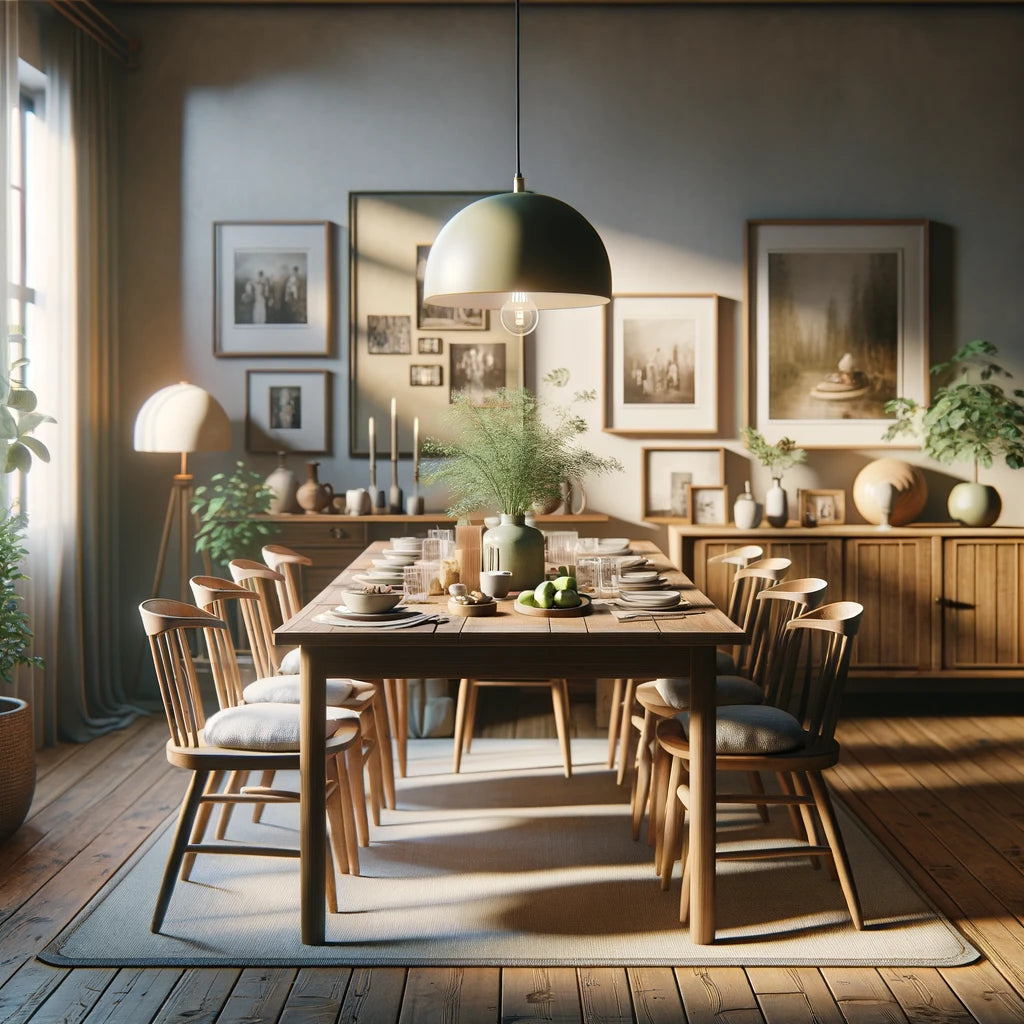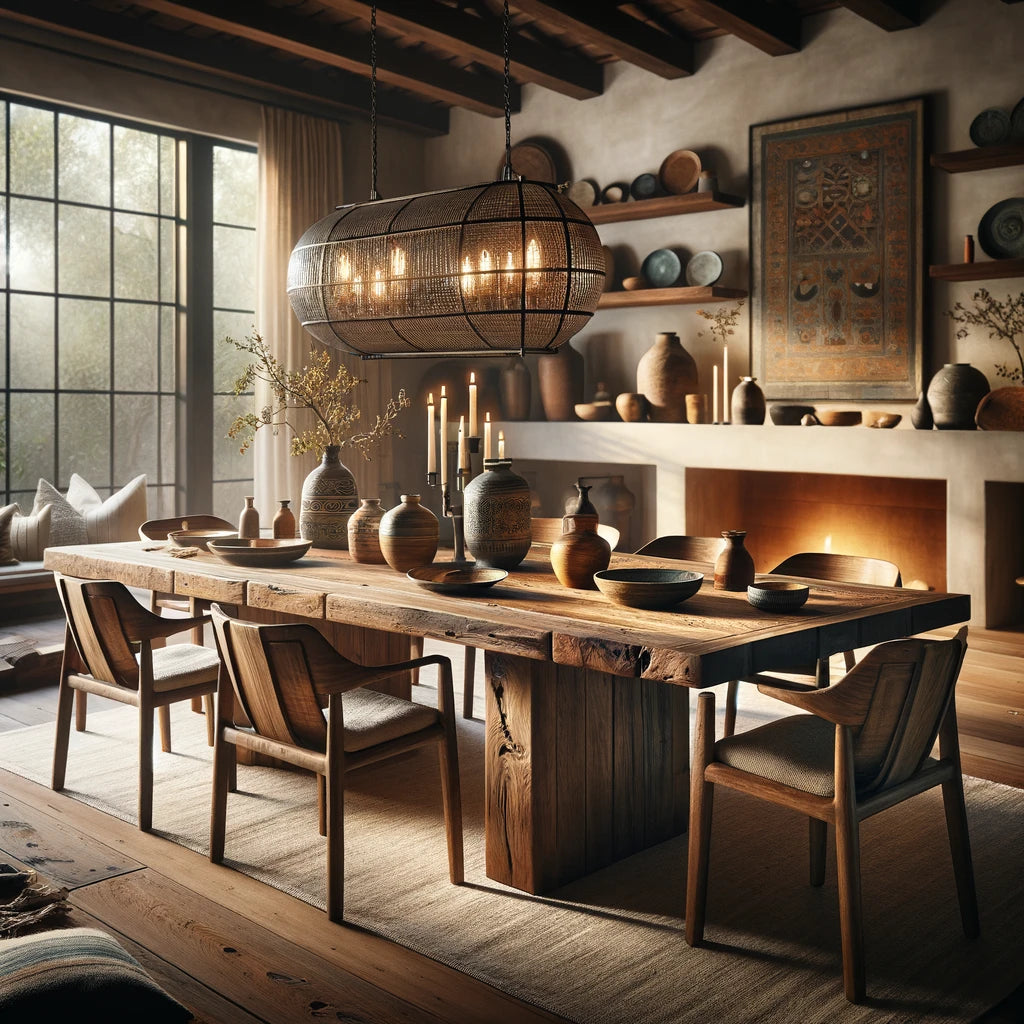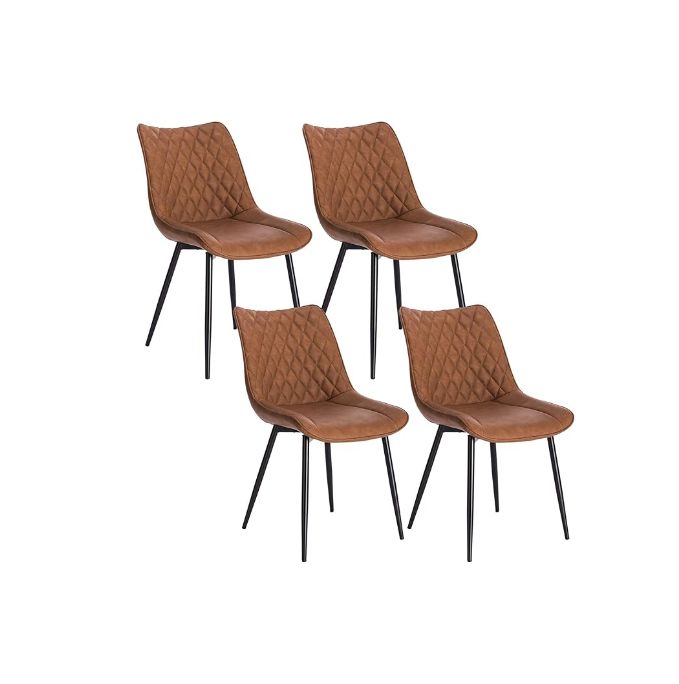In a world increasingly dominated by mass-produced items, the art of handmade furniture stands as a testament to craftsmanship, heritage, and quality.
At Isabella Winchester, while we proudly house a collection of such masterpieces, our passion extends beyond just selling furniture. It's about sharing the rich story, the intricate processes, and the deep value of handcrafted furniture with all who appreciate fine craftsmanship.

Understanding Handmade Furniture
Handmade furniture is more than a functional item; it is a piece of art.
Every curve, joint, and finish reflects the personal touch of a skilled artisan. This craftsmanship results from years of training, an understanding of materials, and a commitment to quality. But what really sets handmade furniture apart is the story behind each piece.
1. The Story in Every Piece
Each item of handmade furniture carries with it a narrative - of the artisan's journey, the inspiration behind its design, and the meticulous processes used to bring it to life.
The grain of the wood, the choice of joinery, the selection of finishes - all these elements come together to tell a story that mass-produced furniture simply cannot.
2. Craftsmanship: A Blend of Skill and Passion
The creation of handmade furniture is a blend of skill and passion.
Artisans dedicate countless hours perfecting their craft, often learning techniques passed down through generations. They imbue every piece with a part of themselves, ensuring that each creation is not just a product, but a personal expression of artistry.
3. The Art of Joinery
Joinery is where the true art of craftsmanship is evident.
Traditional techniques like dovetail or mortise-and-tenon joints not only ensure the structural integrity of the furniture but also showcase the artisan's skill. These joints are designed to withstand the test of time, often becoming stronger as the furniture ages.
4. Finishing Touches
The finish on a piece of handmade furniture is the final flourish in its creation.
It's here that the artisan's attention to detail truly shines. Whether it's a hand-rubbed oil finish, a meticulously applied varnish, or a custom paint job, the finishing process protects the piece and brings out the natural beauty of the materials.

Historical Context and Evolution: The Journey of Furniture Making
Furniture making, a craft as ancient as civilization itself, has evolved significantly through the centuries, reflecting cultural, technological, and artistic developments.
Understanding this evolution helps us appreciate the depth and richness of handmade furniture today.
1. Origins and Ancient Techniques
The story of furniture begins with the earliest civilizations.
From the simple, functional designs of ancient Egypt to the intricate carvings and inlays of the Byzantine era, each period added its own signature to furniture making. Techniques such as joinery, which emerged in ancient Japan and China, have influenced the craft deeply, enduring in modern practices.
2. The Renaissance and Baroque Eras
The Renaissance period brought a revival of classical art and learning, influencing furniture design with its emphasis on symmetry, proportion, and the use of classical motifs.
This era saw the birth of several styles that are still revered, such as the ornate and elaborate designs of the Baroque period.
3. The Industrial Revolution: A Turning Point
The Industrial Revolution marked a significant turning point in furniture making.
Mass production techniques emerged, leading to more affordable furniture but often at the cost of individual craftsmanship. This period laid the groundwork for the modern dichotomy between handcrafted and mass-produced furniture.
4. Modern and Contemporary Movements
The 20th century witnessed various movements, from Art Nouveau's organic forms to the minimalist lines of Mid-Century Modern design.
Each movement reflected the changing tastes, lifestyles, and technological advancements of its time, influencing the aesthetics and functionality of furniture.
5. The Resurgence of Craftsmanship
Today, we see a resurgence in the appreciation for handcrafted furniture as a response to the impersonal nature of mass-produced items.
This renewed interest revives traditional techniques while integrating modern design sensibilities, symbolising a full-circle return to the appreciation of individual artistry and sustainable practices.
The Crafting Process: A Blend of Tradition and Innovation
Material Selection: The Foundation of Handmade Furniture
An integral part of handmade furniture is the deep understanding and respect for the materials used.
Artisans choose woods not just for their beauty, but for their durability, workability, and how they age over time. They might select oak for its strength, pine for its versatility, or walnut for its rich colour. Each material brings its own character to the final piece, contributing to its uniqueness and beauty. This step is crucial as it determines not just the look and feel of the finished product, but also its durability and impact on the environment.
1. Understanding Wood Characteristics
Different types of wood offer unique characteristics:
- Hardwoods like oak, maple, and walnut are renowned for their durability and strength. They are ideal for pieces that need to withstand heavy use, such as dining tables and chairs. Their distinct grain patterns also offer a rich aesthetic appeal.
- Softwoods such as pine and cedar are lighter and easier to work with, making them suitable for intricately designed furniture. They offer a more subtle grain and can be perfect for pieces where a lighter, more airy feel is desired.
- Exotic Woods bring a unique flair to furniture with their unusual grains and colours. However, it's important to ensure that these are ethically and sustainably sourced to avoid contributing to deforestation or habitat destruction.

2. Wood Aging and Behaviour
Understanding how wood behaves over time is crucial.
Different woods age differently – some darken, while others might develop a patina. Skilled craftsmen consider how wood expands and contracts with humidity and temperature changes. This knowledge is essential in ensuring that the joints and overall structure of the furniture remain intact and functional throughout its life.
Design and Planning: The Blueprint of Craftsmanship
The creation of a piece of handmade furniture begins long before the first cut of wood or the first turn of a lathe.
It starts with a thoughtful and detailed design process, which is a critical step in marrying the aesthetic vision with functional requirements.
1. Honouring Traditional Methods
The foundation of furniture design often lies in traditional methods that have stood the test of time.
These methods, passed down through generations of craftsmen, provide a time-honoured framework that ensures structural integrity and aesthetic beauty. For instance, techniques in crafting joinery like dovetails or mortise-and-tenon not only offer robust construction but also add a classic beauty to the furniture.
2. Incorporating Modern Techniques
While respecting tradition, modern craftsmen also embrace contemporary techniques and materials to enhance the furniture’s functionality and durability.
This might include the use of advanced joinery techniques, precision cutting tools, or innovative materials like sustainable composites. These modern elements are integrated carefully to ensure they complement rather than overshadow the traditional craftsmanship.
3. Balancing Aesthetics and Function
A crucial part of the design process is achieving a balance between the visual appeal and practical utility of the piece.
This involves considering the furniture’s proportions, lines, and form. A chair or table isn’t just to be looked at – it needs to be comfortable, stable, and suitable for its intended use. Artisans spend considerable time sketching and modelling (sometimes using 3D software) to visualise how each piece will look and function in a real-world setting.
4. Customization for the Individual
Handmade furniture often offers the flexibility of customization.
During the design phase, craftsmen can tailor the dimensions, materials, and finishes to meet the specific needs and preferences of the customer. This process involves detailed discussions and sometimes multiple iterations of designs to ensure the final product aligns perfectly with the client’s vision.
5. Detailed Planning for Flawless Execution
Finally, meticulous planning is essential to transform a design from paper to reality.
This includes detailed measurements, material lists, and step-by-step plans to guide the crafting process. Such thorough preparation is key to ensuring that the finished piece adheres to the high standards of quality and craftsmanship expected of handmade furniture.
Handcrafting Techniques: The Heart of Artisanal Furniture
In the world of handmade furniture, the techniques employed by artisans are as varied as they are intricate.
These skills, often honed over years of practice, are what imbue each piece of furniture with strength, durability, and a distinct character.
1. Mastering the Art of Carving
Carving is one of the most traditional and artistic techniques in furniture making.
It involves chiselling away wood to create patterns, designs, or even sculptures on the furniture. This can range from simple grooves to elaborate scenes or intricate patterns. The level of detail in carving can significantly enhance the aesthetic appeal of the furniture, making it not just a piece to use but a work of art to admire.
2. The Precision of Joinery
Joinery is the cornerstone of furniture making. It involves the joining together of different pieces of wood to form the structure of the furniture.
Traditional joinery techniques like dovetail, mortise-and-tenon, and box joints are not only aesthetically pleasing but also provide superior strength compared to modern fastening methods. Skilled artisans choose specific types of joints depending on the piece's design and functional requirements.

3. Wood Turning for Symmetry and Shape
Wood turning is a fascinating process used to create symmetrical, round components like table legs and chair spindles.
Using a lathe, the woodworker shapes the wood while it spins at high speeds, allowing for precise control over the diameter and design. This technique requires a steady hand and a keen eye to produce consistently shaped pieces.
4. Steam Bending for Curved Forms
Steam bending is an age-old technique where wood is exposed to steam to make it pliable.
This allows artisans to bend wood into smooth, curved shapes without cutting or carving it. This technique is ideal for creating elegant, organic curves seen in many traditional and contemporary furniture designs.
5. Inlay and Marquetry for Decorative Flair
Inlay and marquetry involve embedding pieces of different woods, metals, or other materials into the surface of the furniture to create decorative patterns or images.
This technique requires precision and an artistic eye, as it involves cutting and fitting tiny pieces together to form detailed designs.
6. Finishing Techniques for Protection and Beauty
Finally, the finishing of the furniture is crucial.
Finishing techniques like sanding, staining, and sealing not only protect the wood from wear and tear but also enhance its natural beauty. Artisans carefully select finishes based on the type of wood, the intended use of the furniture, and the desired aesthetic.
Quality Control and Assurance: Upholding Excellence in Craftsmanship
Ensuring the quality of handmade furniture is a critical aspect of the crafting process, involving rigorous standards and meticulous checks at every stage.
At Isabella Winchester, we take pride in our commitment to excellence, ensuring that each piece of furniture not only meets but exceeds the expectations of our discerning clientele.
1. Selection of Premium Materials
Quality control begins with the selection of materials.
Our artisans choose only the finest woods, ensuring that they are free from defects and suitable for the intended design. This careful selection process lays the foundation for the overall quality and longevity of the furniture.
2. Precision in Crafting
As our craftsmen work on each piece, they adhere to precise measurements and techniques, ensuring consistency and accuracy.
This attention to detail is crucial in maintaining the structural integrity and aesthetic appeal of the furniture.
3. Continuous Monitoring and Checks
Throughout the crafting process, each piece undergoes continuous monitoring and regular checks.
This includes inspecting the stability of joints, the smoothness of surfaces, and the proper alignment of all components. These checks help identify and rectify any issues early in the process.
4. Finishing with Finesse
In the finishing stage, our craftsmen apply stains, paints, and sealants with expert precision.
Each layer is inspected for evenness and quality, ensuring a flawless finish that not only beautifies the piece but also provides lasting protection.
5. Final Inspection and Approval
Before any piece of furniture leaves our workshop, it undergoes a final comprehensive inspection.
This includes a detailed check of every aspect of the piece, from structural soundness to aesthetic perfection. Only after passing this stringent inspection does the furniture receive approval for delivery.
6. Feedback Integration
We value customer feedback as an essential part of our quality control process.
Insights from clients help us continuously refine our techniques and standards, ensuring that the furniture we create not only meets but anticipates the needs and preferences of those who will enjoy it.

Aftercare and Maintenance: Ensuring the Longevity of Your Handmade Furniture
Owning a piece of handmade furniture is not just a purchase but an investment in artistry and quality.
To maintain the beauty and integrity of these pieces over time, proper aftercare and maintenance are essential. At Isabella Winchester, we believe in empowering our clients with the knowledge to care for their furniture, ensuring it remains a cherished part of their home for years to come.
1. Regular Cleaning and Dusting
Dust can accumulate on furniture and mar its appearance.
Regular dusting with a soft, dry cloth is recommended. Avoid using silicone-based furniture polishes or sprays, as these can leave a residue that dulls the wood finish over time.
2. Protecting from Environmental Factors
Handcrafted furniture should be protected from environmental factors such as direct sunlight, extreme temperatures, and humidity fluctuations.
Prolonged exposure to sunlight can fade wood finishes, while extreme temperatures and humidity can cause wood to expand or contract, leading to warping or cracking.
3. Dealing with Spills and Stains
In case of spills, it's important to act quickly.
Blot spills immediately with a soft, slightly damp cloth, and then dry the area with a clean, dry cloth. Avoid using harsh chemicals or abrasive cleaners, as they can damage the finish of the wood.
4. Periodic Maintenance Checks
Periodically check all joints and hardware.
Over time, screws and joints can become loose. Gently tightening them ensures the furniture remains stable and prolongs its life.
5. Professional Repairs for Damage
In case of significant damage or wear, it’s advisable to seek professional help.
Attempting to repair intricate joinery or finishes without proper expertise can lead to further damage. Professionals specialising in handmade furniture can provide the necessary care and restoration.
6. Caring for Upholstery and Soft Furnishings
If your handmade furniture includes upholstery, regular vacuuming with an upholstery attachment can keep it free of dust and dirt.
Attend to any spills on fabric immediately according to the manufacturer’s instructions.
7. Refinishing for a New Lease of Life
Over the years, you might want to have your furniture refinished to restore its original lustre or to update its look.
Refinishing should be done by skilled professionals who understand the specific requirements of handcrafted furniture.

The Benefits of Handmade Furniture
Durability and Longevity: The Enduring Appeal of Handcrafted Furniture
One of the most significant benefits of handcrafted furniture is its exceptional durability and longevity.
Unlike mass-produced items, artisanal furniture is built with a level of care and attention to detail that ensures it can stand the test of time, often becoming treasured heirloom pieces passed down through generations.
1. Quality Materials for Lasting Strength
The foundation of durable furniture lies in the quality of the materials used.
Handcrafted furniture makers often select high-grade woods known for their strength and resistance to wear and tear. Hardwoods like oak, maple, and cherry are popular choices due to their dense grain and natural durability. These woods can withstand daily use and resist damage from factors like moisture and temperature changes.

2. Superior Construction Techniques
The methods used to construct handcrafted furniture are as important as the materials themselves.
Traditional joinery techniques like dovetail or mortise-and-tenon joints are not only aesthetically pleasing but are also far more robust than the glue and nails used in much of today’s mass-produced furniture. These time-tested methods create tight, secure joints that can bear weight and withstand years of use without loosening.
3. Handcrafted for Resilience
Every aspect of handcrafted furniture is considered for durability.
This includes reinforcing stress points, ensuring proper alignment of parts, and meticulous finishing to protect the surface. Artisans also pay close attention to the natural properties of wood, allowing for expansion and contraction with changes in humidity, which prevents cracking and warping.
4. Finishing Touches That Protect
The finish applied to handcrafted furniture not only enhances its beauty but also plays a vital role in its longevity.
High-quality finishes protect the wood from scratches, spills, and fading. Artisans often use finishes that penetrate deep into the wood, providing long-lasting protection while maintaining the wood’s natural feel.
5. Heirloom Potential
The combination of quality materials, expert craftsmanship, and timeless design means that handcrafted furniture is not only built to last but is also worthy of being passed down through generations.
These pieces become more than just furniture; they turn into storied heirlooms, carrying memories and history from one family to the next.
Timeless Beauty: The Everlasting Appeal of Handmade Furniture
Handmade furniture is renowned not just for its durability but also for its timeless beauty.
This enduring appeal is a direct result of the meticulous attention to detail and the high quality of craftsmanship that goes into each piece. Unlike trends that come and go, the beauty of handcrafted furniture lies in its classic aesthetics and the deep connection it fosters with its owners.
1. Craftsmanship That Transcends Trends
The skill and artistry of the craftsmen play a pivotal role in the timeless nature of handmade furniture.
These artisans often spend years perfecting their craft, resulting in furniture that showcases their expertise and dedication. The care and attention given to each curve, joint, and finish mean that each piece is not just made; it's crafted with a level of artistry that transcends fleeting design trends.
2. Unique Designs with a Personal Touch
Every piece of handmade furniture is unique, bearing the distinct touch of its maker.
This uniqueness sets it apart from mass-produced items. The designs, whether influenced by traditional methods or modern aesthetics, carry a personal signature that remains relevant and appealing regardless of changing styles.
3. The Beauty of Natural Materials
The use of high-quality, natural materials like wood, leather, or stone adds to the timeless beauty of handmade furniture.
These materials have an inherent beauty that only enhances with age. The grains, textures, and colours of natural materials are irreplaceable and lend a classic, enduring charm to the furniture.
4. Adaptable to Various Interiors
One of the hallmarks of well-crafted handmade furniture is its versatility. Such pieces can complement a wide range of interior styles, from rustic or traditional to modern or eclectic. This adaptability ensures that the furniture remains stylish and relevant, even as interior design trends evolve.
5. Emotional Connection and Storytelling
Finally, the timeless beauty of handmade furniture is often enriched by the stories and memories it accumulates.
A handcrafted table or chair is not just a piece of furniture but a repository of family gatherings, quiet moments, and life’s milestones. This emotional connection adds an intangible value that never goes out of style.
Eco-Friendly: The Sustainable Choice in Handmade Furniture
One of the most significant advantages of handmade furniture is its environmentally friendly nature.
This sustainable approach is a conscious choice by artisans and manufacturers, focusing on using local materials, minimising waste, and adopting practices that are kind to the planet.
1. Use of Local and Sustainable Materials
Handcrafted furniture often utilises locally sourced materials, reducing the carbon footprint associated with transportation.
By choosing woods from local, sustainably managed forests, artisans ensure that their craft has a minimal environmental impact. This practice supports local ecosystems and economies while ensuring the sustainability of woodworking resources.
2. Longevity Reduces Waste
The durability and longevity of handmade furniture mean that it does not need to be replaced as frequently as mass-produced alternatives.
This longevity translates into less waste over time, as these pieces are less likely to end up in landfills. Moreover, the timeless design of handcrafted furniture ensures it remains in use and cherished for generations, further reducing the cycle of consumption and disposal.
3. Ethical Production Processes
Artisans who create handmade furniture are often deeply committed to ethical production processes.
This includes using non-toxic finishes and adhesives, and employing techniques that minimise energy consumption. Such practices are not only safer for the environment but also for the craftsmen and the end-users.
4. Reduced Environmental Impact of Manufacturing
Handcrafted furniture production typically has a smaller environmental footprint compared to large-scale manufacturing.
The process is more focused on individual craftsmanship than on mass production, which often involves energy-intensive machinery and processes. Artisans’ workshops are usually smaller, more efficient, and less reliant on large-scale industrial resources.
5. Supporting a Culture of Repair and Upcycling
The high quality and timeless design of handmade furniture also support a culture of repair and upcycling.
Instead of disposing of old or worn furniture, it's often possible to restore, refinish, or repurpose these pieces. This approach not only extends the life of the furniture but also embodies an ethos of sustainability and mindful consumption.
6. A Response to Fast Furniture Trends
In a world where ‘fast furniture’ has become prevalent, contributing significantly to environmental degradation, handmade furniture stands as a responsible alternative.
By choosing handcrafted pieces, consumers are rejecting the disposable nature of mass-produced furniture and embracing a more sustainable, mindful approach to furnishing their homes.

Preserving Craftsmanship: Upholding a Time-Honoured Tradition
The art of furniture making is a storied tradition, steeped in skills and knowledge that have been passed down through generations of craftsmen.
This legacy is not just about preserving old techniques; it's about keeping a vital part of our cultural heritage alive. Supporting handmade furniture plays a crucial role in this endeavour.
1. Keeping Traditional Skills Alive
The process of creating handcrafted furniture involves a multitude of skills - from wood selection and treatment to intricate carving and joinery.
These skills have been refined and handed down over centuries, representing a deep understanding of the craft. By supporting handmade furniture, we contribute to the survival of these traditional techniques, ensuring they are not lost to time.
2. Encouraging Artisanal Excellence
Craftsmanship in furniture making is an art form that demands excellence.
Artisans invest years, often decades, in mastering their craft. Supporting this sector encourages a continued pursuit of excellence and innovation in furniture making. It provides a platform for craftsmen to showcase their talent and creativity, keeping the industry vibrant and dynamic.
3. Fostering a Sense of Community and Continuity
The world of handmade furniture is often built around communities of artisans who share knowledge, tools, and techniques.
By supporting these communities, we help maintain a sense of continuity, allowing for the transfer of knowledge from one generation to the next. This sense of community is essential for the preservation and evolution of the craft.
4. Valuing the Human Touch
In an age dominated by automation and mass production, handmade furniture represents a connection to the human touch.
Every handcrafted piece carries the individual imprint of the artisan who made it - a unique blend of personal vision and skill. Supporting this craft values the human element in creation, something that is increasingly precious in our technology-driven world.
5. Contributing to Cultural Diversity
Furniture making techniques vary widely across different cultures and regions, each adding to the rich tapestry of global craftsmanship.
By supporting handmade furniture, especially from various cultures, we contribute to the preservation and appreciation of this diversity. This not only enriches our understanding of different cultures but also brings a wider range of aesthetic and functional choices to consumers.
6. Inspiring Future Generations
When we invest in handmade furniture, we also invest in the future.
This support inspires new generations to take up the mantle of craftsmanship, ensuring that these skills do not become obsolete. It helps in cultivating a new cohort of artisans who respect traditional methods while infusing them with contemporary innovation.
Concluding Remarks

As we reach the end of our exploration into the world of handmade furniture, it's clear that this art form is much more than a mere collection of objects. It's a testament to human creativity, skill, and a deep-rooted respect for materials and traditions. At Isabella Winchester, our dedication goes beyond just crafting and selling furniture; we are committed to preserving a rich heritage, nurturing artisanal skills, and offering our customers pieces that are not only functional but also imbued with stories and soul.
The journey of each piece of furniture, from the careful selection of materials to the meticulous crafting processes, echoes a narrative of dedication and excellence. It's a narrative that celebrates the unique beauty of natural materials, the precision of skilled hands, and the timeless designs that emerge from the synergy of tradition and innovation. Our furniture is not just built; it is lovingly crafted with attention to every detail, ensuring that each piece is as robust in its construction as it is elegant in its appearance.
Our commitment to quality control and assurance, coupled with our guidance on aftercare and maintenance, ensures that each piece of Isabella Winchester furniture not only enhances your space today but also becomes a cherished heirloom for future generations. These pieces are designed to age gracefully, gaining character and telling stories as they become integral parts of your home and family history.
By choosing handmade furniture, you are not only acquiring a piece of furniture. You are supporting a sustainable approach to manufacturing, contributing to the preservation of our environment, and valuing the human touch in a world increasingly dominated by impersonal mass production. You are also becoming a part of a community that cherishes cultural diversity, artisanal excellence, and the continuity of age-old crafting traditions.
At Isabella Winchester, we are honoured to be a part of this story, a story that intertwines the past with the present and crafts a future where craftsmanship is revered, and quality is paramount. We invite you to join us in this celebration of craftsmanship, to experience the profound connection that comes from owning a piece of furniture crafted by hands that understand and respect the art of furniture making.











